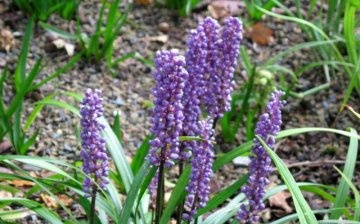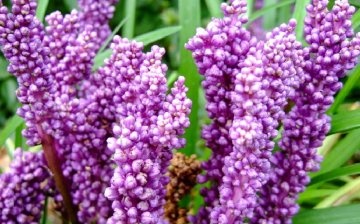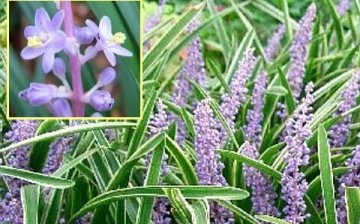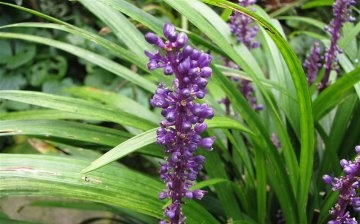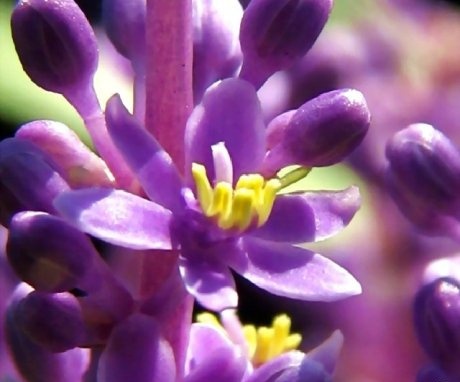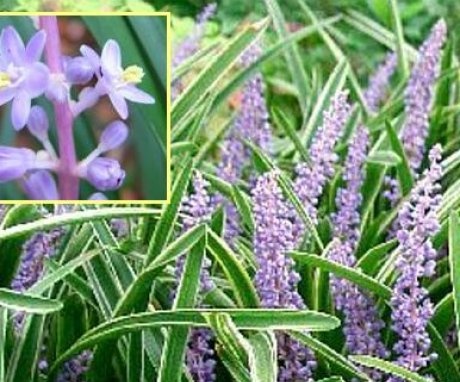Liriope: description, types, cultivation and prevention of plant diseases
Liriope belongs to the lily family. In nature, it can be found on the banks of rivers, in forests and on the slopes of the mountains of Asian countries. Refers to perennial decorative flowering plants. It is often used as a ground cover plant. Looks great on flower beds and rock gardens, planted as a border decoration flower.
Content:
- Dread of lyriope
- Types of lyriope
- Liriope care
- Reproduction of perennial
- Diseases and pests of lyriopa
Dread of lyriope
Liriope blooms only in August, but lasts until frost. This does not prevent him from attracting attention with the splendor of the bush and beautiful leaves. The roots of this plant are fibrous with rare thickenings. They are located shallow in the soil.
The leaves are long, oblong, like those of cereals. Their height can be much higher than flowers.
Peduncles can be very short, buds are loosely distributed in the form of a brush. The flowers are painted in pale purple, white, dark blue, blue tones.
Outwardly a little resemble a lily of the valley flowerbut the bells are slightly smaller. After flowering, fruit boxes appear, divided into two parts. Each contains a seed.
Types of lyriope
Liriope muscari:
- One of the most common types. Its homeland is Japan and China. This species has many different shapes and colors of buds.
- One of the most popular is the variegate variety, its leaves are colored in stripes in two tones, and the flowers are juicy purple tones. There are also varieties with blue, white and purple flowers.
- Plant height can reach 60 cm, and the lowest variety of this species stretches only 20 cm.
- The flowers are located on a high peduncle in the form of a spikelet.
- Represent miniature bells with a diameter of no more than 1 cm.
Liriope spikelet:
- This species can be classified as an evergreen cover plant.
- Its leaves are narrow, oblong, in appearance they resemble onion feathers.
- The flowers are small, up to 0.6 cm, located on short pedicels, which are sometimes not visible from dense bushes.
- This species tolerates cold and frost well. Its homeland is Vietnam, Korea, China and Japan.
Liriope flat-leaved:
- The bushes of this type are medium in size, their height does not exceed 40 cm.
- The leaves are oblong, narrow, colored with longitudinal stripes.
- The flowers are small, their color is dark blue.
Ha Liriope's departure
When choosing a place for planting Liriope, it must be borne in mind that the plant loves soft light and partial shade. In the open sun, the leaves will turn yellow and dry, and flowering will pass very quickly. The soil should be well-drained, as the plant does not tolerate stagnant water well. Also, the soil should be light and fertile, without lime content.
Watering should be regular but limited. Liriope will tolerate drought well and will die if the soil becomes waterlogged.
Also, after watering the land near the bushes, weeds are loosened and removed so that air flows to the roots. Fertilization is necessary in the summer and autumn months. Top dressing takes place 1 time in 1.5-2 months with highly diluted mineral fertilizers.
Flowering lasts a long period, therefore, dried flowers must be regularly removed along with the peduncles.This will give the plant a more aesthetic appearance, and the wilted flower will not draw juices from the bush. The flower is sheltered for the winter in cold regions. To do this, you can use Potentilla, dry leaves or hay. It is important to open in the spring before the leaves begin to rot.
Reproduction of perennial
Liriope can be propagated in two ways: by dividing the bush or by seed.
Reproduction by dividing the bush:
- Spring transplant is the best breeding season with division.
- The bush is well watered and carefully dug up.
- Since the root system deepens slightly, the plant is easily removed from the ground.
- When dividing a bush, it is necessary to calculate so that at least 10 leaves remain on each daughter plant.
- It is necessary to prepare pits in advance for planting new bushes. Do not deepen much, the distance between them should be 35-40 cm.
- Liriope bushes should be planted every three years.
- The plant grows strongly and the larger the bush, the fewer flowers appear on it.
Seed propagation is a more complex process and begins with the preparation of seedlings. This method is used extremely rarely and mainly in industrial conditions.
After transplanting, young bushes must be watered regularly and can be applied several times strengthening fertilizers... The frequency of feeding a young plant is 1-2 times a week for 2 months.
Diseases and pests of lyriopa
Liriope is practically not susceptible to pest attacks. Sometimes aphids or spider mites can be found on flowers and leaves. This problem can be solved by treating the entire plant area. special drugs.
But with improper care or a poor growing place, the bush may die or give poor flowering.
With constant exposure to direct sunlight, especially in the hot summer period, the leaves begin to dry out and die off. If the plant is not shaded, it can die after a short time.
Liriope also does not tolerate frequent watering or constant moist soil. Growing in the shade, the bushes can live on a scant amount of moisture. Waterlogging leads to decay of the roots, which will eventually result in the death of the entire plant.
More information can be found in the video.



